


Welcome to this latest edition of Die-cast Diaries and your regular look at all the news, updates and stories from the fascinating world of Corgi model collecting. Even though we are only a few short weeks into the new year, the launch of any new Corgi range ensures that not only have the development team been kept extremely busy over the previous few months in preparation for the announcement, but there are so many new and exciting models to tell our readers about that the blog team feel like we are playing Die-cast catch up at the moment. Hopefully by now, many of you will have had the opportunity to inspect the latest January – June 2018 model range and spotted one or two items which may be finding their way into your collection. The Die-cast Diaries team are certainly looking forward to bringing you the very latest announcements, product updates and exclusive features over the next few months, as all these models progress towards their respective release dates.
So, what can Corgi collectors look forward to in this latest edition of our blog? Even though the new January – June model range has only just been unveiled, we have already seen the announcement of an ex-catalogue item, which is causing quite a stir amongst die-cast aviation enthusiasts and collectors the world over. We will be bringing you full details of this exciting new project, along with all the latest exclusive pictures taken during the production of our unique Vanguards 21 competition prize, an eclectic mix of classic and contemporary motoring. We will also be showing you an interesting selection of images captured by the Corgi events team, as they start 2018 with the hectic season of trade and toy show events around Europe, before ending in time honoured fashion with a look at some of the latest sample models to arrive on the development desks at Corgi HQ. Our ‘What’s on the desk’ feature showcases some of the models which are fast approaching their release dates, including one model which is proving to be one of the most popular ways aviation enthusiasts intend to mark this year’s RAF Centenary commemorations. Clearly, we have a lot to get through, so let’s begin with a very special model which marks a significant event in the history of aviation and an aircraft flown by arguably the most famous fighter pilot the world has ever known.
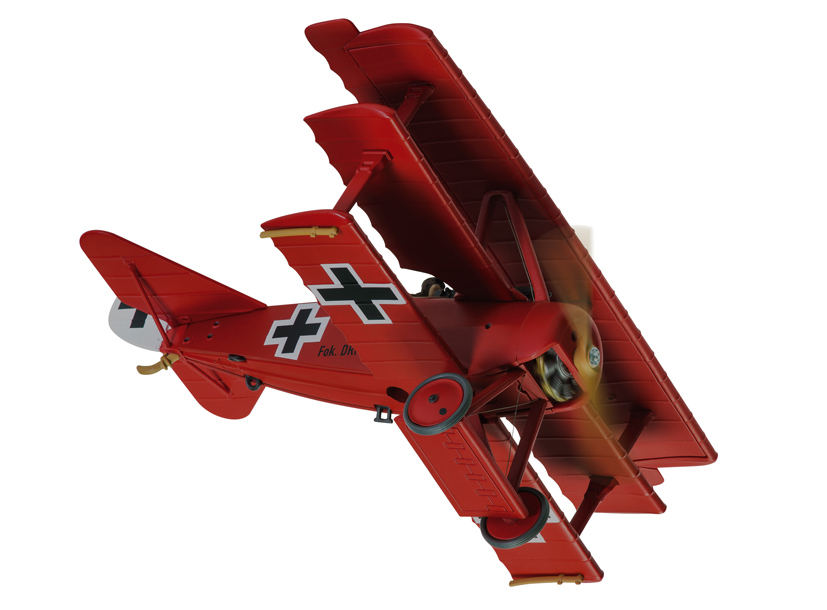
This shot of the pre-production sample model was used to produce the distinctive box artwork for this release
Although the coming months will be dominated by events, media features and news articles in commemoration of the RAF’s Centenary year, 2018 also marks 100 years since the end of the Great War, the war which was meant to end all wars but simply introduced new weapons and methods of waging war more effectively. The First World War witnessed the dramatic development of aviation as a weapon of war, as the early observation balloons designed to allow a better view of the battlefield soon gave way to robust aeroplanes, which were specifically designed to fight for aerial supremacy and deny the enemy the opportunity of effective aerial reconnaissance. It also produced the first celebrated fighter pilots in history, whose exploits would inspire nations and go on to enjoy not only military notoriety, but also to become household names in many parts of the world. At the head of this group of men was undoubtedly the most famous airman of the First World War and arguably the most famous pilot of all time – a man who instilled fear in the hearts of his enemies and inspired the German nation during one of the darkest periods in their history – Manfred Albrecht Freiherr von Richthofen, better known as the Red Baron. Officially credited with 80 confirmed aerial victories, von Richthofen was the most prolific air ace of WWI, but like so many men involved in this terrible conflict, he would not live to see the armistice and the guns falling silent.
To mark the Centenary of the death of Manfred von Richthofen, a special addition to the Aviation Archive was announced recently, which has already seen spectacular levels of pre-order activity taking place, as collectors look to add this distinctive new model to their collections. Specifically requested by our US team, this magnificent new model benefits from beautifully created artwork which sets it apart from any other Aviation Archive release – it also represents arguably one of the most recognisable aircraft in history, flown by perhaps the most famous pilot to ever take to the skies. With this in mind, it will come as no surprise that this has proved to be a particularly popular announcement, with initial allocations selling out on the Corgi website within 90 minutes. Thankfully, we have managed to secure a small additional supply (which is still currently available on the Corgi website), but these will certainly disappear just as quickly, so please make sure you don’t miss out. Let’s take a look at why this particular model has enjoyed such a positive reaction since its announcement last week.
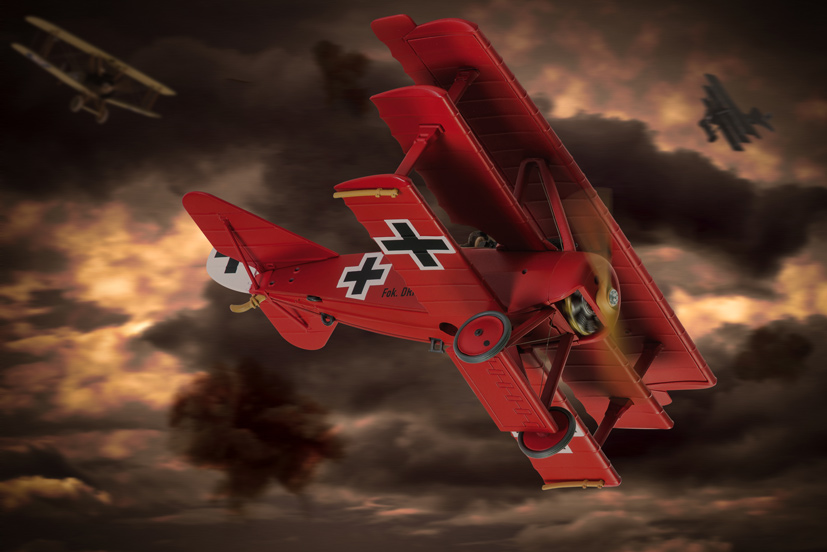
The pre-production sample image above was given a suitably dramatic backdrop by one of our talented graphic designers
Although the life of a Great War aviator was almost as challenging as the conditions endured by the men fighting in the trenches below, flying the latest and most exciting machines produced by man conjured up a perception of chivalrous aerial jousting in the eyes of the general public, who avariciously consumed any information regarding the air war in Europe. Even the exploits of gallant enemy pilots captured the imagination of the British public, who became almost infatuated with the fighting prowess of one man in particular, the Red Baron, Manfred von Richthofen. Stories of his rising victory tally and the distinctive red fighter he flew at the head of his infamous ‘Flying Circus’ were captivating, even though they were engaged in combat with British units of the Royal Flying Corps and Royal Naval Air Service. His exploits did much to raise the profile of young fighter pilots engaged in deadly duels over the trenches of the Western Front and ensured that aviation developed at a pace not restricted by public opinion at home.
His Flying Circus came about as von Richthofen was given command of a new kind of fighting unit, intended to overcome greater numbers of enemy aircraft appearing at that time and combining four squadrons into a large fighting group. These would be sent to specific problem areas on the Western Front, to clear the skies of Allied aircraft, before moving on to the next combat hotspot – something of a travelling aviation troubleshooting unit. Von Richthofen reputedly painted his aircraft red so his pilots could quickly check his position during the melee of combat, but as the reputation of the group began to grow, so other members of the circus also began to paint their aircraft in a similarly garish manner. The brightly coloured aircraft and the fact that the unit would travel from one Western Front combat hotspot to the next quickly earned the unit the now famous name ‘von Richthofen’s Flying Circus’, however, despite this rather jocular title, these airmen were playing a deadly game and the stakes could not be higher. Confident in their leader and their own growing reputation, these brightly coloured aircraft soon became synonymous not only with ease of recognition by fellow pilots of the Jasta, but a boasting challenge to enemy pilots who dared to enter the same airspace.
As one of the most famous pilots in the history of flight, representations of aircraft flown by Manfred von Richthofen have already appeared in the Aviation Archive range and are amongst some of the most collectable models yet released. The first aircraft to join the 1/48th scale Aviation Archive range back in 2007 was an aircraft type with which the Red Baron was to score the majority of his aerial victories, the highly capable Albatros DV fighter – AA37801 marks one of the first aircraft von Richthofen had painted in his famous all-over red markings and represented one of the most effective fighting machines at that stage of the Great Air War. Although only used by von Richthofen to score 19 of his 80 aerial victories, the Fokker DR.1 Triplane has become synonymous with this famous pilot, with many mistakenly assuming that the Driedecker was the only aircraft flown by the Red Baron. This famous machine 425/17 joined the Aviation Archive range in 2009 and has become one of the most sought after models in the history of Corgi aviation models – taking its place as part of a two aircraft set, AA39913 marked the combat in which von Richthofen was involved prior to sustaining the injury which ultimately caused his death and features the Sopwith Camel of Captain Arthur Brown, who was for many years credited with claiming the life of the Red Baron. This extremely appealing set proved to be particularly difficult for collectors in the UK to get hold of, with the majority of the production run destined for the US market – those who did manage to secure one undoubtedly cherish it as one of the most desirable items in their collection.
Marking the centenary commemorations of Manfred von Richthofen’s death, this latest special release presents the collector with another representation of the Fokker DR.1 he was flying on 21st April 1918 when he was seen to make a forced landing behind Allied lines, following combat with British Sopwith Camels of No. 209 Squadron.
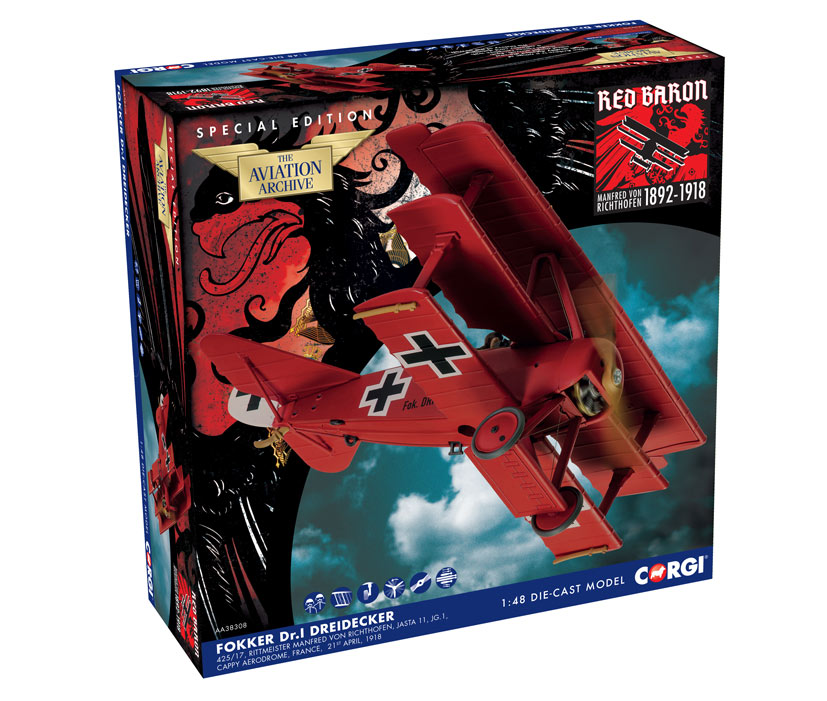
This special commemorative release will benefit from extremely distinctive presentation
The thick fog which greeted the pilots of JG.1 on the morning of Sunday 21st April 1918 meant that there would be no flying until predicted winds promised clearer skies by mid morning. Sure enough, by 10.45 the Jagdstaffel were in position over the Somme valley region, preparing for combat with British reconnaissance aircraft and their fighter protection, led by their inspirational commander Manfred von Richthofen, the celebrated Red Baron, in his distinctive red Fokker Triplane. Having claimed his 79th and 80th victories the previous day, von Richthofen would have a significant distraction during this latest mission, in the form of his young cousin, Wolfram von Richthofen, who was flying his first combat sortie with the squadron. Although specifically instructed only to observe any fighting and not to get involved, Wolfram came under attack by a novice Allied pilot flying a Sopwith Camel, causing the Red Baron to come to his rescue, who seemingly annoyed at this situation, went against all his strict combat doctrines and proceeded to chase the Allied airmen down to extremely low level. With the prevailing wind blowing both aircraft over British and Commonwealth lines, the situation became worse when a second Camel spotted the plight of his inexperienced comrade and dived in to attack the distinctive red Fokker Triplane, which by now had also attracted the attention of all the Allied ground units positioned along the Morlancourt Ridge, overlooking the Somme river. Appearing to have problems with its Maxim guns and unable to fire on the hapless Camel, von Richthofen’s triplane was seen to rear up, before immediately attempting a landing on nearby rough ground. When Allied troops reached the aircraft, its pilot, the feared and respected Manfred von Richthofen was lying dead in the cockpit, killed by a single .303 bullet fired from the ground.
By the time Manfred von Richthofen had taken delivery of his first Fokker Triplane fighter, he already had 59 victories to his name and had gained notoriety as arguably the most gifted pilot the world had ever seen. With his distinctively presented aircraft and privileged family heritage, he soon earned a nickname which would create an aviation legend - the ‘Bloody Red Baron’ of the German Air Service. Becoming something of a celebrity figure, with the apparent chivalry of aerial combat acted as a welcome distraction from the hideous indiscriminate carnage of trench warfare.
Von Richthofen’s final Fokker DR.1 Triplane 425/17 was produced specifically for the famous ace between the end of 1917 and early 1918. As the mount of one of the world’s most famous airmen and a hero to both the Luftstreitkrafte and the German people, the aircraft’s construction was of a particularly high standard and was reported to benefit from superior quality fabric covering and the latest version of interrupter gear, which allowed the aircraft’s two Spandau Maxim machine guns to fire through the arc of the propeller and in the sight-line of the pilot. It was also noted that the engine was of a higher build quality than other similar machines which had fallen into British captivity and were able to be evaluated by Military officials.

Manfred von Richthofen only used Fokker DR.1 425/17 to score his final two victories
Despite the fact that von Richthofen flew several aircraft types during his combat career and gained most of his victories whilst using different versions of Albatros fighters, the Fokker Triplane is undoubtedly the aircraft with which he is most commonly associated. This may simply be due to the fact that this red Fokker Triplane is the aircraft which complements the legend of the Bloody Red Baron most effectively, or that it was regarded by the general public as the epitome of German Great War fighter technology, but whatever the reason, Manfred von Richthofen has become inextricably linked with this diminutive fighting aeroplane. Fokker Triplane 425/17 is without doubt, one of the most famous aircraft in the history of flight and was the mount of the Red Baron whilst claiming his final two aerial victories against British Sopwith Camels on 20th April 1918 and also the machine in which he met his death the following day. Although fatally injured by a single .303 bullet coming from heavy ground fire, von Richthofen was able to safely land his Triplane behind Allied lines, only to succumb to his injury moments later. With his body dragged from the cockpit and knowing the significance of this incident, Allied troops stripped the Red Baron’s aircraft of anything they could quickly remove, with the trophy hunting quickly resulting in an official account of the aircraft supposedly being damaged by artillery fire. As a feared, yet respected enemy, Manfred von Richthofen was buried with full military honours at Bertangles cemetery on 22nd April 1918, where he was laid to rest amongst the fallen of his enemies, just eleven days before what would have been his 26th birthday.
This very special Manfred von Richthofen commemorative release (AA38308) is already proving to be an incredibly popular addition to the Aviation Archive range and collectors are advised to head for the Corgi website or their usual model supplier to ensure they are able to add this classic release to their collection. The scheduled release date for this fantastic new model is June 2018.

With the latest collection of Vanguards models unleashed on the die-cast world just a few short weeks ago, we are pleased to report that interest in our competition to mark the 21st anniversary of the range has proved to be equally successful. Indeed, this unique one of one hand produced 1977 Ford Escort Mk2 RS Mexico wearing the new Ford RS Nitrous Blue colour which is being produced by Vanguards research guru Mark Pinnigar has resulted in large numbers of visitors to our Corgi competitions page, each one hoping to be in with a chance of winning this very special model. We are pleased to report that this exciting project is also being followed by Practical Classics magazine, the world’s biggest selling hands-on classic car magazine, who will be including a feature on our unique model in the next edition of their magazine. For this reason and following receipt of a number of specific reader requests, we have made the unprecedented decision to re-open the competition, allowing Practical Classics readers (and others) the opportunity to view the Vanguards 21 competitions page and enter the competition if they so wish. The final closing date for entries will now be midnight on Monday 5th March and we will also be adding two runners up prizes to the competition, which will be linked to the project – we will bring you full details of these additions in the next edition of Die-cast Diaries.
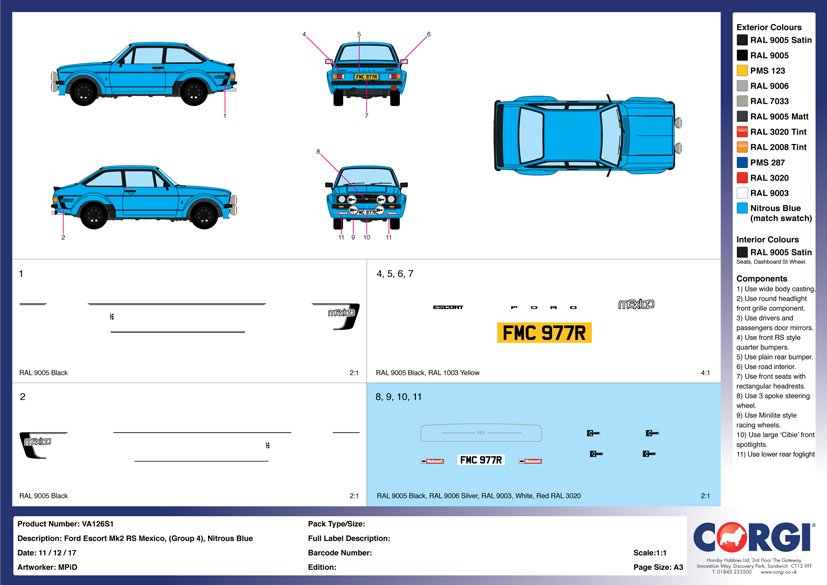
A full decoration guide has been produced in support of this exciting Vanguards project
Mark has been working on producing the prize model over the past few weeks and has kindly kept us updated on his progress. Although you may think that producing a 1/43rd scale die-cast model from a collection of expertly produced metal and plastic parts would not be a challenge for a man of Mark’s experience, he has been explaining that the cold weather has been causing him more than a few problems. As the paints he is using are genuine Ford colours and Mark’s studio for producing the model is part of his garage, the ambient temperature and humidity over the past few weeks have not been particularly favourable to the painting process – indeed, speaking to him earlier today, he has only just confirmed that the sun came out enough for him to add the latest coat to this rather complicated paint finish.
Mark informed us that in order to replicate this beautiful colour, he had to apply a tri-coat painting process, once the model has been effectively primed. For the priming job, he uses an etching primer, which really allows the paint to bite into the surface of the metal and will hopefully avoid the flaking which can occur with lower quality primers – unfortunately for Mark, any flaking or bubbling will result in stripping the model and starting the entire process again, something he is clearly keen to avoid. The next stage is to apply the base coat, which is the striking bright vibrant blue, a solid colour and the one which looks so impressive on the new Ford Focus RS.
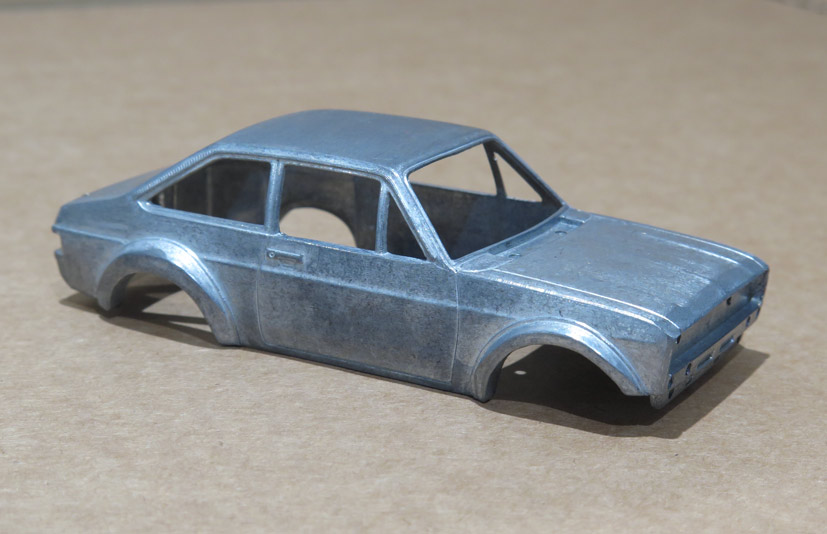
The cast Escort Mk2 RS Mexico awaits some special painting attention
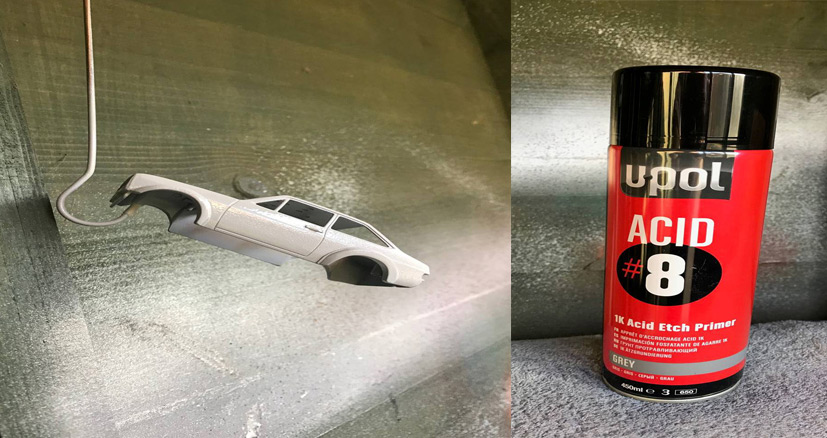
A quality primer coat is essential if this special model is to sport its smart new paintwork
The next coat is a rather special one and is a very fine pearlescent effect finish, which is held in a clear carrier base – this layer gives this beautiful colour its unusual appearance and is incredibly difficult to replicate on a scale model. Since we have been talking about this project, many people in the Corgi office have commented on how many of these distinctive Focus RS cars they have seen on their travels and how it is easy to spot this unique colour. Although it appears in most light to be a single, flat colour, viewing it in bright sunlight uncovers its spectacular secret as the fine metallic pearlescent qualities of the paint are revealed in all their glory. The final stage of the process is to give the model a clear lacquered finish, which seals in the paintwork and gives the model a deep shine.

Using genuine Ford manufactured paints, the application process has posed quite a challenge for Mark, as he attempts to replicate the unique finish of the new RS Nitrous Blue
Mark is quick to point out that this clever use of paint by Ford helps to give this colour a unique quality – by not mixing the pearl effect with the base colour and instead laying it on top, the colour can look dramatically different dependent on the prevailing light conditions. A huge selling point with this handsome new Ford RS model, it has been incredibly challenging to replicate this process on a scale model representation, but the trouble will certainly be worth it for one lucky Vanguards collector. Applying this very new colour to a classic 1977 Escort Mk2 RS Mexico was a stoke of modelling genius and we very much look forward to bringing you pictures of the finished model and announcing on who our competition winner is in a forthcoming edition of Die-cast Diaries. For now, thank you to Mark for this latest update and don’t forget to visit our Corgi competition page, for full details on how you could be in with a chance of winning this fantastic prize.

The impressive Hornby Hobbies stand at the recent Nuremberg Toy Fair
The announcement of any new Corgi model range is both a time of great excitement for model collectors around the world and the culmination of many months of extremely hard work for the Corgi team. Obviously keen to see how well the new range is received by our loyal collectors, the sales and marketing teams are not allowed to rest on their laurels for long, as the beginning of any new year also heralds the start of the busy trade preview season and toy shows in both London and Nuremberg. With one following quickly after another, this is a significant logistic challenge for the Corgi team, who have to arrange for all the latest models to be displayed effectively at several events in the UK, before quickly heading off for the Nuremberg event, which is the world’s biggest international toy fair and a significant occasion in the annual toy and hobby calendar.
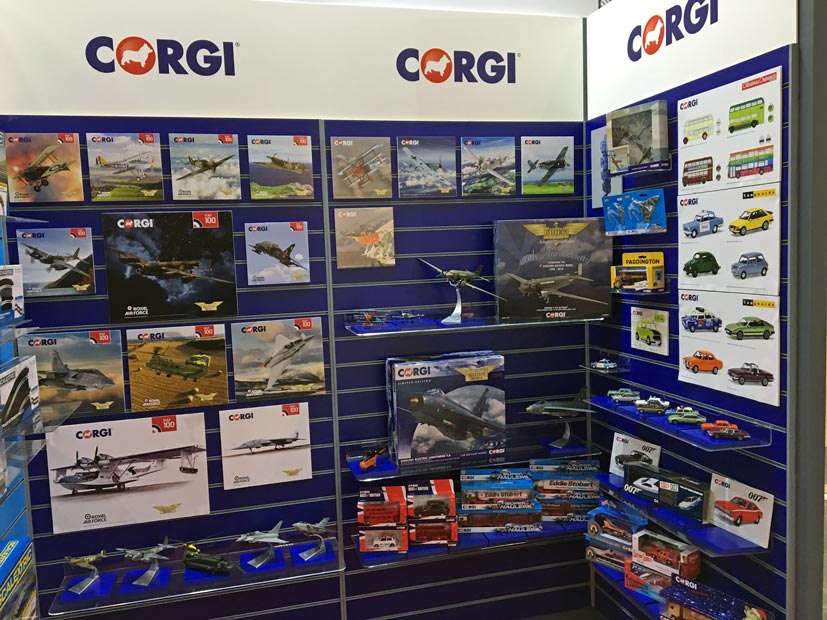
The Corgi display section from the 2018 London Toy Fair
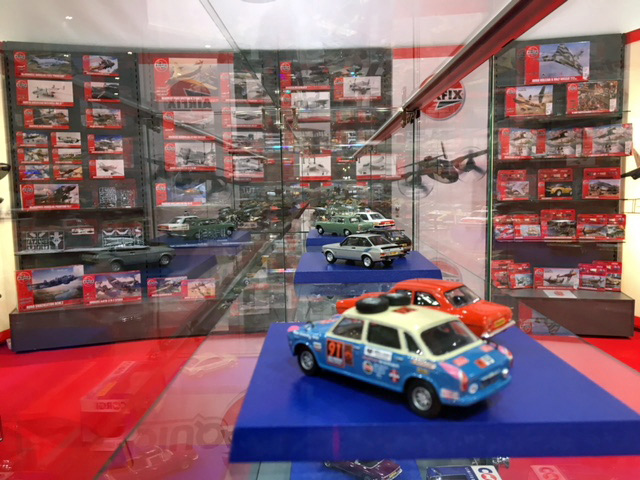
Vanguards models take centre stage at the Nuremberg International Toy event
Only recently back from their Nuremberg show attendance, the Hornby Hobbies events team have kindly provided us with a selection of images showing the various displays at both London and Nuremberg and we thought you might like to see the Corgi displays from both events. Although this is an opportunity for the marketing teams to showcase all the latest models which will be tempting collectors over the coming few months, many of the items on show are either prototype samples, or the hand decorated samples which were produced to allow catalogue images to be obtained. These models have to work extremely hard and this punishing early season schedule can take its toll, with many suffering varying degrees of damage during the numerous packing, unpacking and displaying requirements placed upon them. Nevertheless, these models play an important role in support of any new range launch and if you are ever lucky enough to see them, help to illustrate the impeding die-cast delights coming later in the year.
We end this latest edition of our blog with a look at a selection of the latest pre-production sample models to arrive with the development team at Corgi HQ – this feature has proved to be one of the most popular with our readers over the past couple of years and even though we know most of you are fully aware that these models are still at sample stage and do not represent the final releases themselves, we do still like to remind you from time to time. The Corgi development team are rightly proud of the work they do and would usually not like images of sample models to be circulated whilst they are still in the checking stage. They are fully aware that some of these models may contain errors and inaccuracies which they will have already picked up and will not appear on the production model and generally feel that the sight of such things may unnecessarily worry collectors who may be looking forward to a particular release. Although never keen to show images of model projects in less than their best condition, they do realise the level of interest our readers have in these sample models and allow us to show them for that reason – they just like us to remind you of their pre-production status from time to time.
The latest parcel of sample models to arrive at Corgi HQ will be of great interest to the Aviation Archive collector and whilst we are aware that this latest edition of our blog is rather heavily weighted towards aviation subject matter, the situation will certainly even itself out before the end of the year-let’s take a look at the latest selection of sample arrivals:
AA39105 – Westland Whirlwind HAR.1, XA868, Royal Navy, HMS Protector, 1963.
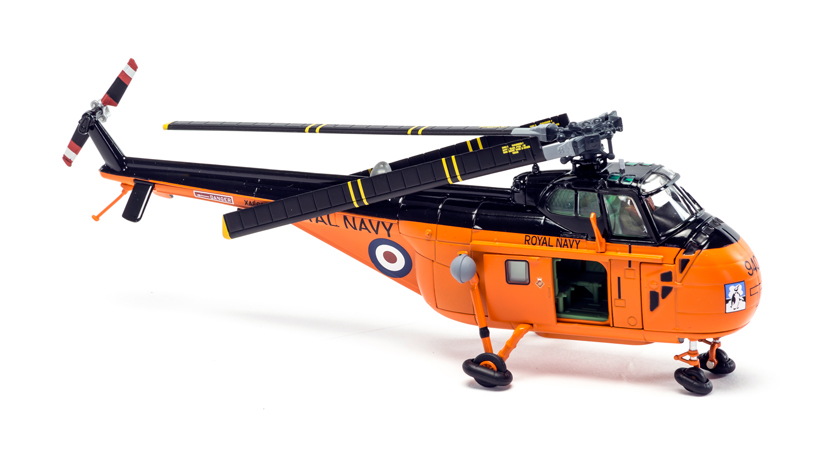
This handsome Whirlwind makes a colourful addition to any collection of rotary models
One of the most interesting helicopter schemes to join the Aviation Archive range in recent years is this striking Westland Whirlwind, resplendent in the livery of a machine which served on board HMS Protector during her patrols in the inhospitable waters of Antarctica. The first Westland built Whirlwind HAR.1 helicopters entered service with the Royal Navy in July 1954, although Fleet Air Arm pilots were already experienced in operating American built versions of the aircraft. Joining No.848 Naval Air Squadron in the Search & Rescue and utility roles, these capable helicopters operated from land based stations and on amphibious operations at sea, providing the Navy with a highly capable new aircraft.
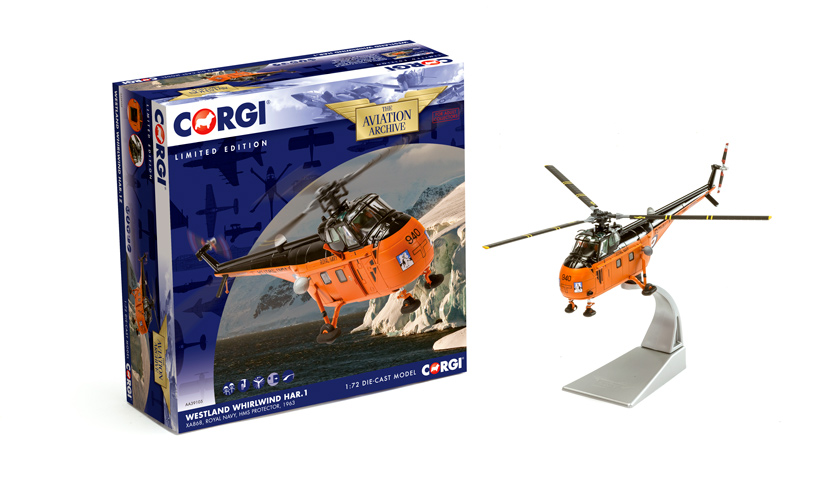
The sample model is pictured beside the packaging which will accompany this release
Royal Navy Whirlwind HAR.1s also served aboard Ice Patrol Ship HMS Protector (A146) during her long ranging Antarctic patrols from 1955, which required them to fly above some of the most inhospitable seas in the world. The re-fitted vessel was capable of carrying two Whirlwind helicopters and operating them from rather basic hangar and flight deck facilities, but providing the ship with invaluable airborne support. Whirlwinds that served on board HMS Protector during these important patrols were adorned with an attractive penguin motif on each side of the helicopters nose, in recognition of this period of their service careers.
This attractive Whirlwind model (AA39105) is currently scheduled for a May release.
AA33617 – Panavia Tornado GR.4, ZA461, RAF No.15 Squadron, Lossiemouth, Special Centenary Scheme
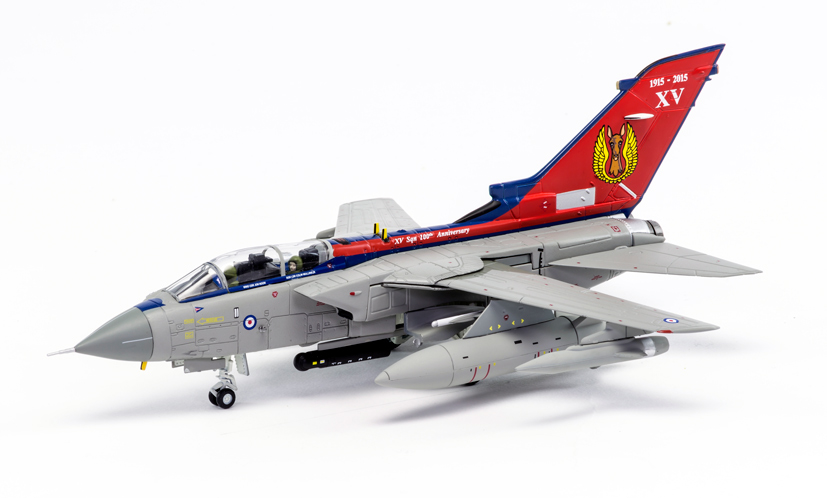
This latest RAF Tornado release is an absolute cracker and one of the most appealing in the range to date
As far as attractive aircraft of the RAF are concerned, there can be few as distinctive as this beautifully presented Tornado GR.4, which wears the special centenary scheme of RAF No. 15 Squadron and is one of the most popular models in the 2017 July – December model range. In this Centenary year of the Royal Air Force, we can hopefully expect this significant occasion to attract plenty of media attention and form the basis of a spectacular year for Airshows in the UK. In advance of these commemorations, a number of individual RAF Squadrons had already marked their Centenary years in style and delighted aviation enthusiasts by presenting one of their aircraft in special commemorative markings. Without doubt, one of the most attractive schemes applied to an RAF jet was the one which adorned Panavia Tornado GR.4 ZA461 of No.15(R) Squadron, whilst it was still based at Lossiemouth in Northern Scotland. With the impending drawdown of the remaining RAF Tornado force looming, this aircraft became something of a talismanic airframe for the ‘Mighty Fin’ and the proud service record of this magnificent aircraft. Sadly, No.15 Squadron disbanded in March 2017, ending a glorious 102 years of service with the Royal Flying Corps and Royal Air Force, whilst also bringing to an end Scotland’s long association with the Panavia Tornado. The RAFs last three remaining Tornado Squadrons are all now based at Marham in Norfolk, where they will remain until their intended service withdrawal date in 2019.

In the twilight of its service career, this attractive release will be a must for any self-respecting Tonka fan
Benefitting from much of the advanced technology developed during the controversially cancelled TSR.2 project, the Panavia Tornado was a Tri-national programme to develop one of the most sophisticated all weather strike attack aircraft in the world. With three major partners developing the aircraft and sharing production costs, it was hoped that economies of scale and shared technology would allow each country to introduce a highly advanced strike aircraft that would act as a significant deterrent to the Warsaw Pact nations. With its variable geometry wings and large tail, the distinctive Tornado is all about speed and power and during a long and successful service career, it has successfully taken part in a number of combat situations, most notably during the Gulf War of 1991. With many operators looking to replace the Tornado with fifth generation fighter/strike aircraft, the days of this Cold War warrior are now numbered, but if called upon in the near future, the capable Tornado will be ready for action. With a March release date expected, this handsome new Tornado is just around the die-cast corner.

This spectacular Chinook is already destined to become one of the most popular Corgi releases of the year
The final pre-production sample model to be reviewed in this edition is a real die-cast classic and one of the most popular models from the latest January – June 2018 range. As one of the world’s most impressive heavy lift helicopters, the mighty Chinook has become one of the most important aircraft of the modern era and is never too far away from the action, delivering troops and supplies or providing casualty evacuation support. As the largest Chinook operator outside the US, the home of Britain’s Chinook force is RAF Odiham in Hampshire but as their aircraft are always in high demand, many of the based Chinooks can be deployed on operations at any time. RAF No.27 Squadron have been associated with the Chinook since 1993, but the unit can trace their history back to 1915 and the first aircraft they operated, the Martinsyde G.100 ‘Elephant’. This rather large and cumbersome aircraft was used by the squadron for bombing and reconnaissance operations during the Great War, with an elephant also being used as the centrepiece of the No. 27 Squadron badge. To mark the centenary commemorations of the squadron, Chinook HC.4 ZA683 was given a special paint scheme, which featured an elephants head on the tail rotor housing and a profile of the Martinsyde G.100 in a commemorative badge on the fuselage. This was certainly one of the most dramatic centenary schemes applied to an RAF aircraft to date.
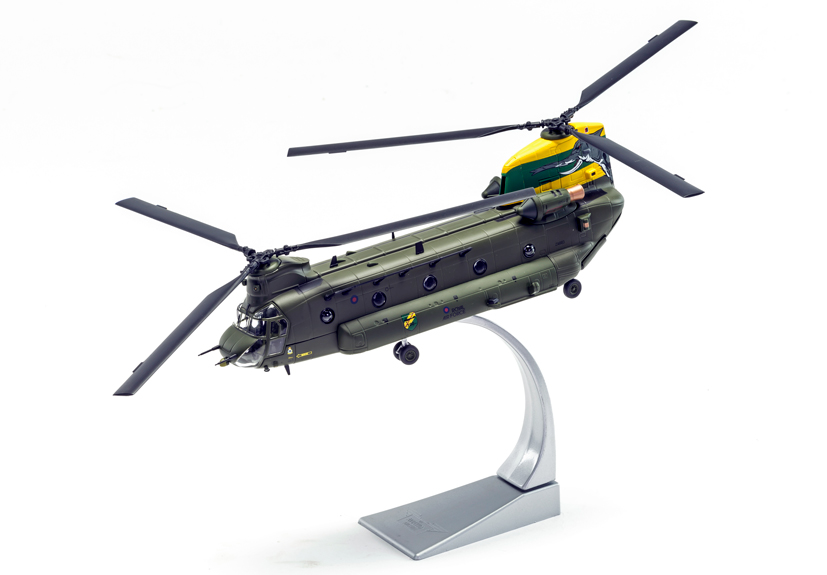
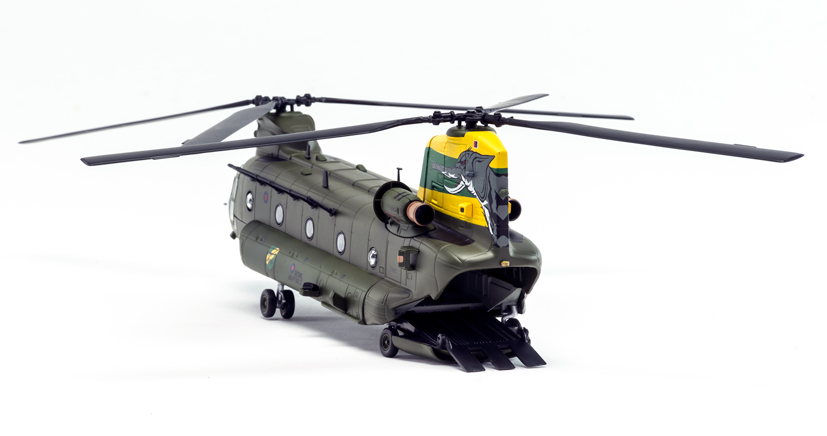
Entering RAF service in late 1980, the Boeing Chinook has become one of the most important air assets available to British military forces. As the nature of warfare continues to evolve, the ability to deploy, supply and extract troops in all terrains and environments has taken on critical importance and the mighty Chinook is the most effective aircraft for this task. For this reason, the RAF’s Chinook force are amongst the most active aircraft in their current inventory and in great demand wherever UK forces are deployed throughout the world. For these reasons, the fact that Chinook HC.4 ZA683 was able to wear its special Centenary scheme throughout 2016 is a story in itself and one which must have required significant effort by members of No.27 Squadron. The logistics of planning, designing and gaining official authorisation for the project in a relatively short space of time must have been quite a challenge, let alone ensuring that the aircraft was available to spend time in the paint shops to benefit from the application of this attractive commemorative scheme. Their efforts resulted in a unique appearance for an RAF Chinook, which was a source of pride for squadron members and a highly prized catch for aviation enthusiasts – unfortunately, it proved to be a short-lived splash of colour, as the aircraft was repainted back into its standard operational scheme at the end of 2016.

Look out for this packaging in model stores soon, as it marks one of the most popular Aviation Archive releases of 2018
Interestingly, these images illustrate why pre-production sample models are so important to a particular project and allow the development team to pick up inaccuracies before the model comes to market. The original hand decorated sample model did not display the distinctive elephant marking on the rear rotor stack correctly and whilst this was immediately picked up by the development team, it still managed to leave its mark on the project. As these early models are invariably used for pack and catalogue artwork, you can still see images of the incorrect markings on the box artwork and in the latest catalogue, due to the fact that the graphic design teams have to work so far in advance of catalogue publication and it was just too late to change the image they had worked on. This does however make for an interesting story and will be just another reason why this spectacular new model will be one of the releases of 2018 – RAF Chinook AA34214 is also currently scheduled for a March release.
We are afraid that’s all we have for you in this latest edition of Die-cast Diaries but hope that some of the features and exclusive images were of interest to you. We are always interested to hear from readers who may like to suggest a subject they would like to see covered in a future edition of Die-cast Diaries, if those who might like to send in pictures of their own collection. If this applies to you, please let us have your ideas using our diecastdiaries@corgi.co.uk e-mail address, where we very much look forward to hearing from you.

A final close up view of the impressive box artwork produced for our new commemorative ‘Red Baron’ release
If you can’t wait for the next edition of our blog, there are plenty of Corgi model discussions taking place over on our Die-Cast Diaries forum along with the news, photographs and collecting banter on our ever popular Facebook and Twitter social media accounts – could we please ask that you use the #CorgiDiecastDiaries when posting, as this helps direct new collectors to our blog pages. We look forward to reading all your latest Corgi collecting discussions and pictures of your favourite models over the next few weeks.
Finally, we would like to thank each and every one of you for your continued support of our blog and we look forward to bringing you plenty of Corgi related news, features and updates in the months to come. The next edition of Die-cast Diaries will be published on Friday 9th March.
The Corgi Die-cast Diaries Team
Back to the Die-cast Diaries home page
© Hornby Hobbies Ltd. All rights reserved.